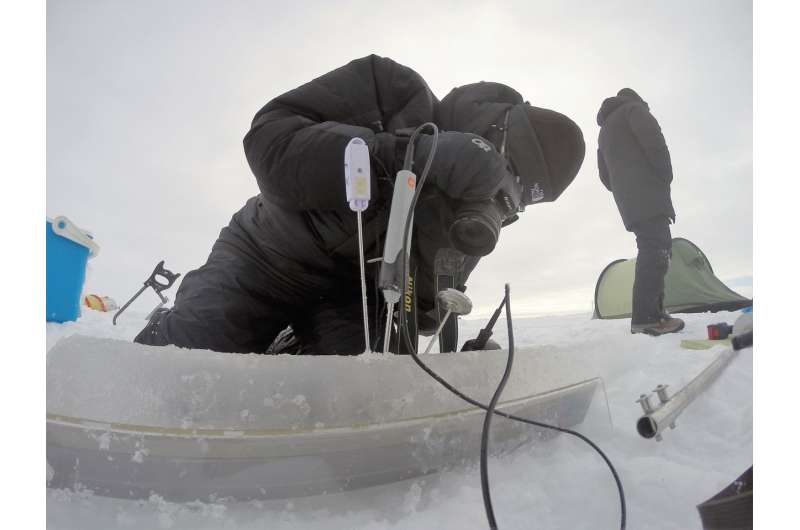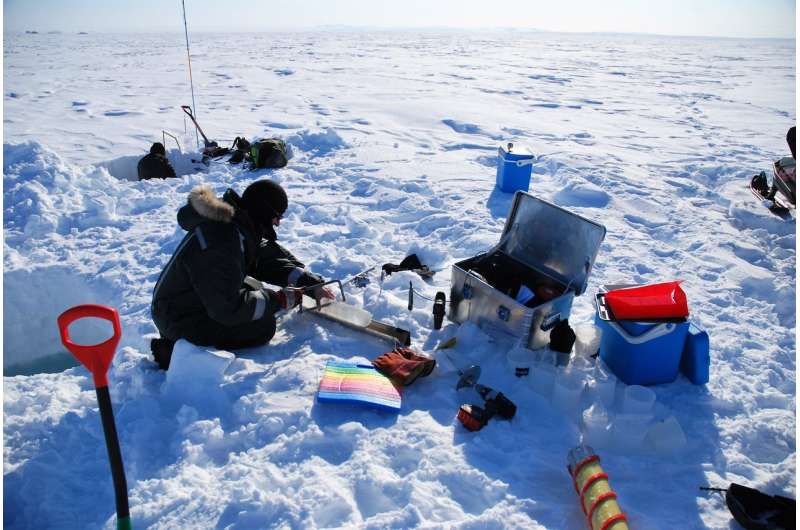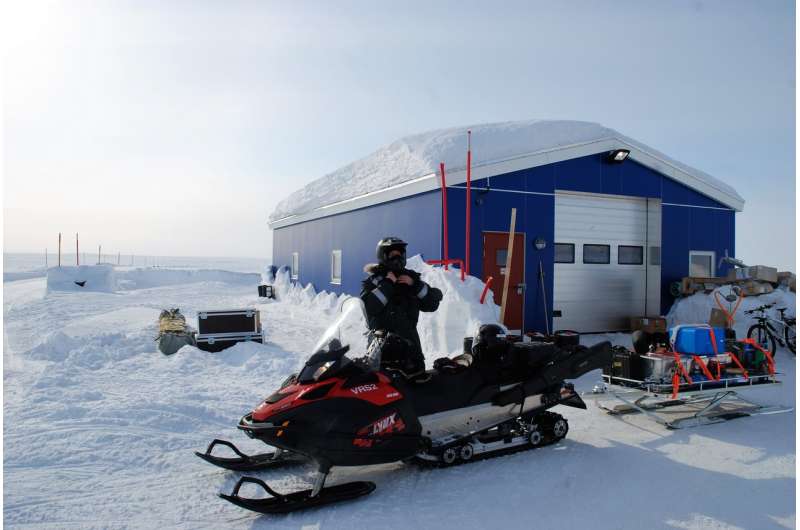Measuring of temperature down through one of the collected ice cores. Credit: Kasper Hancke
Researchers from Aarhus University have measured a new world record: Small ice algae on the underside of the Arctic sea ice live and grow at a light level corresponding to only 0.02 percent of the light at the surface of the ice. Algae are the primary component of the Arctic food web and produce food far earlier in the year than previously thought.
It is pitch dark all winter in the Arctic. And even in the spring, the compact ice and snow layer allows only a tiny amount of sunlight to penetrate into the sea. But on the underside of the sea ice, microscopic algae have adapted to the extreme prevailing conditions. Among these algae are diatoms that reside on the underside of the ice and in small brine channels, where heavier saline water flows out of the ice and into the sea.
In this extreme environment, temperatures are below the freezing point and salinity is higher than in seawater, and light penetration is extremely low for a large part of the year. All algae require light, and it has long been a mystery why algae are found in a habitat with almost no light for long periods of the year.
Researchers from Aarhus University went to the Villum Research Station in the northeastern corner of Greenland to study the living conditions of the algae. The results of the research efforts have just been published in the Journal of Geophysical Research.
The temperature in North-East Greenland may decrease to -20 oC in May, so researchers need to be well-dressed when the laboratory is located on the surface of the sea ice. Credit: Kasper Hancke
"We worked on the sea ice in April and May, where there was a metre of sea ice and a metre of snow on top of the ice. With special ice corers, we drilled holes in the ice so that we could measure the ice algae on the underside and collect samples," says Lars Chresten Lund-Hansen of Aarhus University, who was in charge of the studies.
As primary producers constitute the base of the food web, ice algae are essential for the vulnerable Arctic marine ecosystem. Especially in the early spring where plankton algae in the sea are not yet active.
"Our measurements showed that the ice algae began to grow at a light intensity below 0.17 μmol photons m-2 s-1. This corresponds to less than 0.02 percent of the amount of light that reaches the surface of the snow on a sunny day," says Kasper Hancke, currently working at the Norwegian Institute for Water Research (NIVA) in Oslo, who was responsible for the field work.
This is the lowest light level where active photosynthesis and growth of ice algae have been observed.
The researchers have to transport their equipment to the ice from Villum Research Station with snowmobiles. Credit: Stine Højlund Pedersen
The general view has been that ice algae do not obtain sufficient light for growth when they are covered by more than 30 to 50 cm of snow and ice. The new measurements completely change that view and show that ice algae may play an important role much earlier in the spring in the Arctic than hitherto assumed.
During May, the depth of the snow on top of the sea ice did not change significantly—showing only a reduction from 110 to 91 cm. However, when the snow became warmer, its optical conditions changed so that a larger amount of light reached the underside of the sea ice, boosting the growth of the ice algae.
"Temperatures are rising in the Arctic. When the snow on top of the ice gets warmer, the algae residing on the underside of the ice receive more light. This may significantly impact the growth of the algae and the extent of the spring bloom. This new knowledge must be considered in the puzzle of how the Arctic will respond to a warmer world," says Lars Chresten Lund-Hansen.
More information: Kasper Hancke et al, Extreme Low Light Requirement for Algae Growth Underneath Sea Ice: A Case Study From Station Nord, NE Greenland, Journal of Geophysical Research: Oceans (2018). DOI: 10.1002/2017JC013263
Journal information: Journal of Geophysical Research
Provided by Aarhus University

























